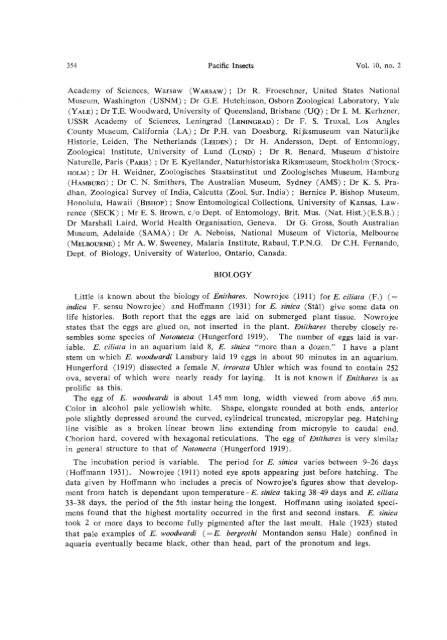THE ENITHARES (Hemiptera-Heteroptera: Notonectidae) OF THE ...
THE ENITHARES (Hemiptera-Heteroptera: Notonectidae) OF THE ...
THE ENITHARES (Hemiptera-Heteroptera: Notonectidae) OF THE ...
You also want an ePaper? Increase the reach of your titles
YUMPU automatically turns print PDFs into web optimized ePapers that Google loves.
354 Pacific Insects Vol. 10, no. 2<br />
Academy of Sciences, Warsaw (WARSAW) ; Dr R. Froeschner, United States National<br />
Museum, Washington (USNM) ; Dr G.E. Hutchinson, Osborn Zoological Laboratory, Yale<br />
(YALE) ; Dr T.E. Woodward, University of Queensland, Brisbane (UQ) ; Dr I. M. Kerhzner,<br />
USSR Academy of Sciences, Leningrad (LENINGRAD) ; Dr F. S. Truxal, Los Angles<br />
County Museum, California (LA) ; Dr P.H. van Doesburg, Rijksmuseum van Naturlijke<br />
Historie, Leiden, The Netherlands (LEIDEN) ; Dr H. Andersson, Dept, of Entomology,<br />
Zoological Institute, University of Lund (LUND) ; Dr R. Benard, Museum d'histoire<br />
Naturelle, Paris (PARIS) ; Dr E. Kyellander, Naturhistoriska Riksmuseum, Stockholm (STOCK<br />
HOLM) ; Dr H. Weidner, Zoologisches Staatsinstitut und Zoologisches Museum, Hamburg<br />
(HAMBURG) ; Dr C. N. Smithers, The Australian Museum, Sydney (AMS) ; Dr K. S. Pradhan,<br />
Zoological Survey of India, Calcutta (Zool. Sur. India) ; Bernice P. Bishop Museum,<br />
Honolulu, Hawaii (BISHOP) ; Snow Entomological Collections, University of Kansas, Lawrence<br />
(SECK) ; Mr E. S. Brown, c/o Dept, of Entomology, Brit. Mus. (Nat. Hist.) (E.S.B.) ;<br />
Dr Marshall Laird, World Health Organisation, Geneva. Dr G. Gross, South Australian<br />
Museum, Adelaide (SAMA) ; Dr A. Neboiss, National Museum of Victoria, Melbourne<br />
(MELBOURNE) ; Mr A. W. Sweeney, Malaria Institute, Rabaul, T.P.N.G. Dr CH. Fernando,<br />
Dept, of Biology, University of Waterloo, Ontario, Canada.<br />
BIOLOGY<br />
Little is known about the biology of Enithares. Nowrojee (1911) iov E. ciliata (F.) ( =<br />
indica F. sensu Nowrojee) and Hoffmann (1931) for E. Sinica (Stal) give some data on<br />
life histories. Both report that the eggs are laid on submerged plant tissue. Nowrojee<br />
states that the eggs are glued on, not inserted in the plant. Enithares thereby closely resembles<br />
some species of Notonecta (Hungerford 1919). The number of eggs laid is variable.<br />
E. ciliata in an aquarium laid 8, E. Sinica "more than a dozen." I have a plant<br />
stem on which E. woodwardi Lansbury laid 19 eggs in about 90 minutes in an aquarium.<br />
Hungerford (1919) dissected a female N irrorata Uhler which was found to contain 252<br />
ova, several of which were nearly ready for laying. It is not known if Enithares is as<br />
prolific as this.<br />
The Qgg of E. woodwardi is about 1.45 mm long, width viewed from above .65 mm.<br />
Color in alcohol pale yellowish white. Shape, elongate rounded at both ends, anterior<br />
pole slightly depressed around the curved, cylindrical truncated, micropylar peg. Hatching<br />
line visible as a broken linear brown line extending from micropyle to caudal end.<br />
Chorion hard, covered with hexagonal reticulations. The Qgg of Enithares is very similar<br />
in general structure to that of Notonecta (Hungerford 1919).<br />
The incubation period is variable. The period for E. Sinica varies between 9-26 days<br />
(Hoffmann 1931). Nowrojee (1911) noted eye spots appearing just before hatching. The<br />
data given by Hoffmann who includes a precis of Nowrojee's figures show that development<br />
from hatch is dependant upon temperature - E. Sinica taking 38-49 days and E. ciliata<br />
33-38 days, the period of the 5th instar being the longest. Hoffmann using isolated specimens<br />
found that the highest mortality occurred in the first and second instars. E. Sinica<br />
took 2 or more days to become fully pigmented after the last moult. Hale (1923) stated<br />
that pale examples of E. woodwardi (=£*. bergrothi Montandon sensu Hale) confined in<br />
aquaria eventually became black, other than head, part of the pronotum and legs.

















